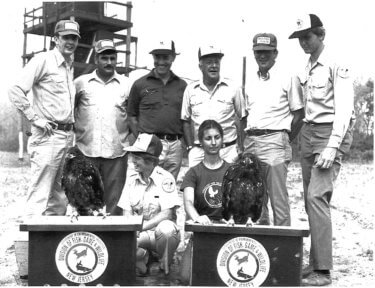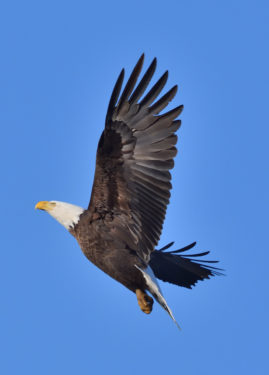A Symbol of Hope
In the United States, Bald Eagles are a symbol of strength, courage, and patriotism. But for Natural Lands, they are also a symbol of hope. Not hope as a passive wish but as an action, as a force that motivates us, that can unite people towards a common goal.

Photo: Natural Lands archives
Today, Bald Eagles are common in our region, but it wasn’t always so. In the early 1980s, only a single nesting pair of Bald Eagles remained in New Jersey. The nest was located deep within a vast, marshy forest at Glades Wildlife Refuge. Despite the excellent habitat, the eagle pair hadn’t successfully hatched a chick in years, which scientists believed to be due to residual pesticides in the environment despite the ban on DDT four years earlier. So a daring plan was hatched: in the spring of 1982, staff members replaced the sterile egg the female eagle had laid with a live Bald Eagle chick. And then they waited. About a half-hour after the swap, the adult eagles landed in the nest and accepted the foster eaglet as their own.
The following year, the breeding pair produced two eggs which were removed for incubation by the US Fish and Wildlife Service, since the eggshells were about 20 percent thinner than normal and too fragile to survive in the wild. The hatchlings—named “Stars” and “Stripes”—were then returned to the nest to be reared by their parents.
Buoyed by their successes, Natural Lands staff—under the direction of state and federal wildlife experts—constructed a “hacking tower” the following year. Small feeding doors and one-way glass panels allowed staff to feed and monitor eagles with minimal human contact. The first residents of the hacking tower were four young eagles donated to the project by the Canadian government. Dubbed “Faith,” “Hope,” “Charity,” and “Courage,” the six-week-old raptors were the first of a total 45 Bald Eagles successfully reared and released from the Glades hacking towers over several years to repopulate New Jersey.
Thanks to these and other conservation efforts, the state’s Bald Eagle population has rebounded from the brink of extinction. In 2007, the species was removed from the Endangered Species list. Today, the Bald Eagle soars above many of our preserves, including Glades Wildlife Refuge, where the effort began, Harold N. Peek Preserve, and Bryn Coed Preserve.

Photo: Bill Moses
To get from the brink of extinction to a thriving population was an international effort that took government and nonprofit teamwork, the expertise of scientists, and the long-term support of a community.
For us, the Bald Eagle is a symbol of what we can do when we commit our time, knowledge, and our care. It is the staff who fed chicks through one-way glass panels in a hacking tower five decades ago. The Natural Lands members who renew their financial support year after year. The volunteers who get dirty pulling invasive plants so beneficial species can emerge. And it is our staff members who plant wildflower meadows and work to preserve open spaces that are critical for the survival of Bald Eagles on down to tiny pollinators.
Each small step, along a trail of decades, is made with the hope that we can restore what was nearly lost and prevent what may disappear tomorrow. The Bald Eagles have shown us what’s possible when hope unites us.
Read more of the story about how the Bald Eagle returned to our region.
Support our continued efforts to care for nature and be a part of our next story of hope.
